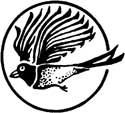To Monday, November 13, 2017
 Fall in North America comes as springtime ignites the vast eucalypt forests Down Under, signaling the rattling hilarity of Laughing Kookaburras initiating courtship and defending their territories on the ancient island continent of Australia. Approximately the size of the conterminous 48 states of the U.S., our tour in Southeast Australia is designed for anyone who has ever imagined gazing straight into the eyes of a curious, 6’ tall Emu—second largest bird on earth, watching a powerful Malleefowl adding compost to its enormous nest, or witnessing flights of indescribably colored Rainbow Lorikeets and dazzling Crimson Rosellas. Australia is not only a continent where over 300 birds—40% of its 776 species—are endemic, it is a place where pigeons are often as colorful as parrots and where male wrens—actually members of the fairywren tribe—wear brilliant shades of blue, red, or purple for their November nuptial plumage. Boasting about 50 species of kangaroos and their kin alone, Australia has been the center of speciation for the marsupial clan since Australia drifted free of Gondwanaland 55 million years ago. We hope to see three of the largest species of the kangaroo clan. We will also make a special effort to find the primitive Short-beaked Echidna, possible on either the mainland or in Tasmania, an egg-laying mammal resembling a hedgehog or a miniature porcupine. Our route additionally provides us with a realistic opportunity to spot an endangered Koala. Southeast Australia is vast, and the enormity of the country is amplified by the variety of its landscapes. Our loop through the states of New South Wales and Victoria will take us over the Great Dividing Range through the tallest eucalyptus forest in Australia—some trees are over 300’—into the vast plains of the Murray River. Here we will bird savannah, salt bush flats, and river red gum riparian groves, before striking out for the chaparral-like habitat known as mallee. Some of the birds we may see include Chestnut Quail-Dove, Australian King-Parrot, Major Mitchell’s or Pink Cockatoo, Powerful Owl, Australian Owlet-Nightjar, Tawny Frogmouth, Painted Honeyeater, Superb Lyrebird, and a host of other endemic birds. One evening we’ll make a special effort to see the enigmatic Plains-wanderer, a nocturnal bird that Phil Maher only pinned down for birders and scientists alike in 1980. Aside from this unusual species that looks like a cross between a quail and a shorebird, a Plains-wanderer excursion gives us a chance for other birds such as Inland Dotterel or one of world’s truly unique marsupials, the Fat-tailed Dunnart. Next we’ll hop 160 miles offshore to Tasmania. The island state of Tasmania hosts an additional 12 species of endemic birds, and we may see them all in our first 24 hours. Beyond endemics, however, the wet temperate forest of Tasmania is home to one of the most beautiful avifaunas in all the world. Species here include both Green and Eastern Rosellas, Shining Bronze-Cuckoo, Masked Owl, Superb Fairy-Wren, Southern Emu-Wren, Spotted Pardalote, Striated Fieldwren, and New Holland Honeyeater, along with lovely Pink, Flame, and Scarlet Robins. A full day pelagic trip from Eaglehawk Neck on the southern coast of Tasmania brings us into the purlieu of no fewer than seven species of albatrosses, as well as a wide assortment of petrels, storm-petrels, prions, and shearwaters. Evening spotlighting forays may reveal mammals as varied as Platypus, Eastern Barred Bandicoot, or the furtive Tasmanian Devil. If you have always wanted to see the birds and the wildlife of Australia, we invite you to join us this November for spring “down under” in the southern hemisphere.
Fall in North America comes as springtime ignites the vast eucalypt forests Down Under, signaling the rattling hilarity of Laughing Kookaburras initiating courtship and defending their territories on the ancient island continent of Australia. Approximately the size of the conterminous 48 states of the U.S., our tour in Southeast Australia is designed for anyone who has ever imagined gazing straight into the eyes of a curious, 6’ tall Emu—second largest bird on earth, watching a powerful Malleefowl adding compost to its enormous nest, or witnessing flights of indescribably colored Rainbow Lorikeets and dazzling Crimson Rosellas. Australia is not only a continent where over 300 birds—40% of its 776 species—are endemic, it is a place where pigeons are often as colorful as parrots and where male wrens—actually members of the fairywren tribe—wear brilliant shades of blue, red, or purple for their November nuptial plumage. Boasting about 50 species of kangaroos and their kin alone, Australia has been the center of speciation for the marsupial clan since Australia drifted free of Gondwanaland 55 million years ago. We hope to see three of the largest species of the kangaroo clan. We will also make a special effort to find the primitive Short-beaked Echidna, possible on either the mainland or in Tasmania, an egg-laying mammal resembling a hedgehog or a miniature porcupine. Our route additionally provides us with a realistic opportunity to spot an endangered Koala. Southeast Australia is vast, and the enormity of the country is amplified by the variety of its landscapes. Our loop through the states of New South Wales and Victoria will take us over the Great Dividing Range through the tallest eucalyptus forest in Australia—some trees are over 300’—into the vast plains of the Murray River. Here we will bird savannah, salt bush flats, and river red gum riparian groves, before striking out for the chaparral-like habitat known as mallee. Some of the birds we may see include Chestnut Quail-Dove, Australian King-Parrot, Major Mitchell’s or Pink Cockatoo, Powerful Owl, Australian Owlet-Nightjar, Tawny Frogmouth, Painted Honeyeater, Superb Lyrebird, and a host of other endemic birds. One evening we’ll make a special effort to see the enigmatic Plains-wanderer, a nocturnal bird that Phil Maher only pinned down for birders and scientists alike in 1980. Aside from this unusual species that looks like a cross between a quail and a shorebird, a Plains-wanderer excursion gives us a chance for other birds such as Inland Dotterel or one of world’s truly unique marsupials, the Fat-tailed Dunnart. Next we’ll hop 160 miles offshore to Tasmania. The island state of Tasmania hosts an additional 12 species of endemic birds, and we may see them all in our first 24 hours. Beyond endemics, however, the wet temperate forest of Tasmania is home to one of the most beautiful avifaunas in all the world. Species here include both Green and Eastern Rosellas, Shining Bronze-Cuckoo, Masked Owl, Superb Fairy-Wren, Southern Emu-Wren, Spotted Pardalote, Striated Fieldwren, and New Holland Honeyeater, along with lovely Pink, Flame, and Scarlet Robins. A full day pelagic trip from Eaglehawk Neck on the southern coast of Tasmania brings us into the purlieu of no fewer than seven species of albatrosses, as well as a wide assortment of petrels, storm-petrels, prions, and shearwaters. Evening spotlighting forays may reveal mammals as varied as Platypus, Eastern Barred Bandicoot, or the furtive Tasmanian Devil. If you have always wanted to see the birds and the wildlife of Australia, we invite you to join us this November for spring “down under” in the southern hemisphere.
Leaders: Steve Davidson, Phil Maher & Rick Taylor
Cost of Australia & Tasmania includes all accommodations, all meals, all ground transportation, and all entrance fees beginning and ending in Melbourne—$9,195.
TO REGISTER: Print out a PDF Registration Form, call us at (520) 558-2351 or This email address is being protected from spambots. You need JavaScript enabled to view it..
Photo: Pretty-faced Wallaby
Photo by: Rick Taylor







